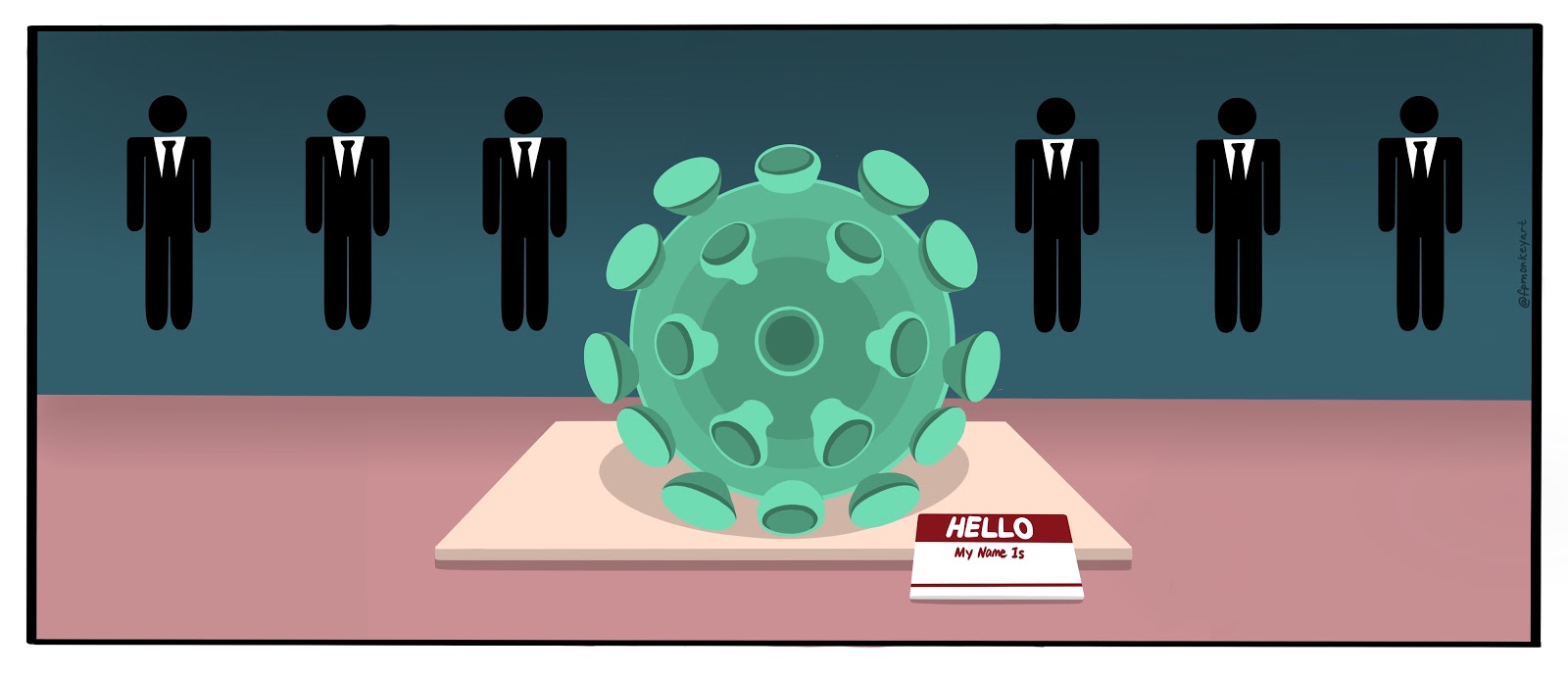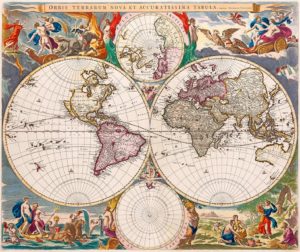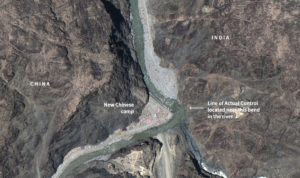In Taiwan, is it ‘COVID-19’ or ‘Wuhan pneumonia’?

Illustration by Julia YH
Taiwanese President Tsai Ing-wen (蔡英文 Cài Yīngwén) calls the coronavirus two different names. On her English-language Twitter and in the English portion of an April 1 address, she has used the term coined by the World Health Organization (WHO): COVID-19. But in Chinese during that same address, she called it Wǔhàn fèiyán (武漢肺炎) — “Wuhan pneumonia.” The shift between terms reflects a debate in Taiwan between Tsai’s Democratic Progressive Party (DPP) and leaders of the Kuomintang (KMT) opposition, as well as between Taiwan and the People’s Republic of China.
Like Tsai, I have also thought carefully about what to call the novel coronavirus in Chinese. In a mid-January WeChat post, I went with “Wuhan pneumonia,” but much has changed in the two and a half months since. I’ve deleted that post because, among other reasons, I no longer stand behind the term “Wuhan pneumonia” — it just makes no sense for me to perpetuate the association of a borderless disease with a specific region.
Still, Tsai’s use of “Wuhan pneumonia” is not the same as American president Donald Trump’s use of “Chinese Virus,” and I can understand why she might choose to do so for a domestic audience. Let me explain.
Naming conventions for the novel coronavirus have evolved in both Chinese and English, and the debate continues as to what it should be called. The Chinese state-run People’s Daily used the term “Wuhan pneumonia” in early January, as in “散步武漢肺炎謠言8人被依法處理” (sànbù Wǔhàn fèiyán yáoyán 8 rén bèi yīfǎ chǔlǐ — “Eight People Face Legal Consequences for Spreading Rumors on Wuhan Pneumonia”), and, “武漢肺炎病例初判為新型冠狀病毒” (Wǔhàn fèiyán bìnglì chū pàn wèi xīnxíng guānzhuàng bìngdú — “Early Investigation Suggests Wuhan Pneumonia a Novel Coronavirus”). This publication itself headlined a January 6 article, “Wuhan’s Mystery Pneumonia Spreads.” Some Western news outlets used the phrase “Wuhan coronavirus” in early headlines to distinguish COVID-19 from other coronaviruses like SARS and MERS. These headlines were written at a time when there were very few cases of the virus, and nearly all of them were known to be in Wuhan; they do not read as stigmatizing in their context.
Following WHO advice against naming conventions attached to specific places, most Western news outlets now simply call the virus the coronavirus, or its official WHO name, “COVID-19.” Of course, the United States president remained defiant, calling it the “Chinese Virus” until a couple weeks ago. And then there’s Taiwan, where the Central Epidemic Command Center (中央流行疫情指揮中心 zhōngyāng liúxíng yìqíng zhǐhuī zhōngxīn), President Tsai, and major news outlets continue to refer to the virus in Chinese as “Wuhan pneumonia.”
Those who use that term insist it is not discriminatory. Premier Su Tseng-chang (蘇貞昌, Sū zhēnchāng) of the DPP said in a Q&A at the Legislative Yuan last Tuesday that he and others use the term “because the virus outbreak began in Wuhan, just the way other diseases have become known by area names, such as German measles, Japanese encephalitis, and athlete’s foot (known in Taiwan as ‘Hong Kong foot’),” according to reporting from the Taipei Times.
Su also suggests that Taiwan has no reason to follow WHO conventions since the organization is, in his opinion, “China-controlled.” WHO membership is only given to United Nations member nations, which Taiwan is not. Taiwan is therefore locked out — an awkward reality for WHO, an organization that in theory avoids politics.
Others in Taiwan disagree with Su’s assessment. KMT Taipei City Council Member Lo Chih-chiang (羅智強 Luó Zhìqiáng) urged the Minister of Health and Welfare, Chen Shih-chung (陳時中, Chén Shízhōng), to consider the “discriminatory nature” of the phrase “Wuhan pneumonia” in a March 31 Facebook post. He characterized naming viruses based on their point of origin as a “last-century notion,” and pointed out that even Trump has stopped using the term “Chinese virus.” Asked whether Lo’s comments represent the KMT’s official position, Director General of the KMT Cultural and Communications Committee Wang Yu-min (王育敏 Wáng Yùmǐn) told reporters that the KMT has been consistent in its use of the phrase “novel corona-pneumonia” (新冠肺炎, xīn guān fèiyán), and that the DPP’s continued use of “Wuhan pneumonia” might make outside onlookers believe there is a “spirit of anti-Chinese political thinking” behind the effort to control the epidemic. Their proposed phrase is an apparent compromise between “Wuhan pneumonia” and the phrase used in Chinese state media, 新型冠状病毒 xīnxíng guānzhuàng bìngdú — “novel coronavirus.” The latter is undeniably a mouthful that KMT leaders apparently wish to simplify.
Critics of the phrase are also worried that it is stoking anti-mainland sentiment in Taiwan. In early March, a Google Doc petition began circulating among Taiwanese academics that criticized the Taiwanese Center for Disease Control for advocating closing its borders to mainland students and travelers. They also brought up the so-called “Xiǎomíng (小明) incident,” in which the mainland-born son of a cross-strait couple was trapped with his mother in Hubei after travel restrictions allowed only Taiwanese citizens to return. Minister of Health and Welfare Chen Shih-chung doubled down on the ban at a February press conference, saying, “Nationality can be chosen. They have already chosen [Xiaoming’s] nationality, and did not choose Taiwanese nationality. Now, they must make arrangements on their own and bear the consequences of their choices.” The writers of the petition, and writers of articles in Chinese state media, argue that calling the virus “Wuhan pneumonia” adds insult to the injuries caused by closed borders and enforced travel restrictions.
Like every major issue that divides the people of Taiwan, the COVID-19 crisis is playing out under the broader debate of Taiwan-China relations. The “Wuhan pneumonia” debate is not about semantics, but power. Taiwan is at a power disadvantage, defenders of the phrase argue, and we should be pointing our fingers at the countries who block it out of the WHO, not condemning Taiwan for ignoring international conventions. There is truth in that argument. But while I recognize the hypocrisy in demanding Taiwan use the WHO-approved name, I am still not convinced that simply because other diseases have been named after places in the past, “Wuhan pneumonia” is, therefore, an appropriate name for COVID-19. I also do not think that it is particularly coherent politics for the DPP to disregard the conventions of an organization that both President Tsai’s government and leaders of the KMT agree Taiwan ought to be allowed to join.
There is ultimately a philosophical question on the extent to which Taiwan can be said to ever discriminate against its more powerful neighbor. The harm that China causes Taiwan on a global scale seems, on balance, greater than the harm that a phrase can cause. But that doesn’t change the fact that some people do mean harm by it. In January, Apple Daily headlined an article, “Disgusting! Video of Chinese People Eating Bats Exposed,” and called the virus “Chinese Wuhan (Novel Coronavirus) Pneumonia.” The article sensationalizes and shames what it claims to be the cause of the COVID-19 crisis, and it does not avoid emphasizing the mainland Chinese-ness at the heart of that cause. The subtext of the article is clearly to emphasize how different the People’s Republic of China is from Taiwan, where something like this could presumably never occur.
While Chinese people might feel victimized — and rightly so — by such language, Taiwanese people could surely point to their own stockpile of articles in Chinese media that make them feel dehumanized. Some in Taiwan would argue that those examples outweigh any examples to the contrary, and that international organizations are invested in preserving a status quo that excludes Taiwan. Others in China argue the opposite, and insist that the consistent praise that Western leaders and media express toward Taiwan proves that the global community is against China and on Taiwan’s side. Both arguments are just truthful enough for reasonable people to believe. And so the tennis match never ends.
Regarding my decision to stop using “Wuhan pneumonia,” I can assure you it is not because I have been persuaded by the People’s Daily. One of my main reasons, quite simply, is that while COVID-19 can cause pneumonia, it is not actually pneumonia. Here, the KMT’s proposed phrase, “novel corona-pneumonia,” also falls short of scientific accuracy. And while I recognize the politics at hand are more nuanced for Taiwanese people, I feel my position as an American would render my use of “Wuhan pneumonia” too close to Trump’s “Chinese Virus” for comfort. Trump — as Kaiser Kuo wrote in this space two weeks ago — has been using the phrase for purely political gain, to divert attention from his own colossal bungling of the U.S. response to this outbreak. It was petty and has had real consequences for people of East Asian descent in the U.S.
And as for Tsai Ing-wen using “COVID-19” when speaking English and “Wuhan pneumonia” when speaking Chinese, her move suggests she might actually agree with KMT spokesperson Wang Yu-min’s concern about “outside onlookers.” A broad, English-speaking audience would likely balk at a phrase that sounds so similar to Trump’s “Chinese Virus.” Within its Chinese-language context of a cross-strait cold war, as well as the KMT-DPP divide, her use of “Wuhan pneumonia” feels like a jab at her pro-Beijing rivals. It is the sort of politicking from which neither China, Taiwan, the U.S., nor, it increasingly seems, any other place is immune — even during a pandemic.





